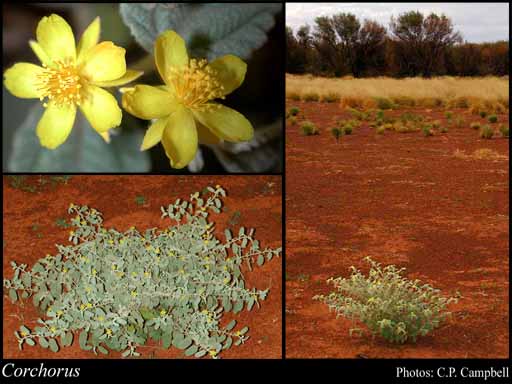- Reference
- Sp.Pl. [Linnaeus] 2:529 (1753)
- Name Status
- Current

Scientific Description
Family Tiliaceae.
Habit and leaf form. Shrubs, or herbs. Herbs annual, or perennial. Leptocaul. Mesophytic. Leaves alternate; spiral; petiolate; non-sheathing; simple. Leaf blades entire; conspicuously asymmetric, or not conspicuously asymmetric; palmately veined. Leaves with stipules. Stipules intrapetiolar; free of one another; caducous. Leaf blade margins crenate, or serrate, or dentate (occasionally with the basal teeth prolonged into long setaceous points). Leaves without a persistent basal meristem. Leaf anatomy. Hairs present (hairs simple, stellate or stellate-dentritic). Stem anatomy. Nodes tri-lacunar. Secondary thickening developing from a conventional cambial ring.
Reproductive type, pollination. Fertile flowers hermaphrodite. Unisexual flowers absent. Plants hermaphrodite.
Inflorescence and flower features. Flowers solitary, or aggregated in ‘inflorescences’. Inflorescence few-flowered, or many-flowered. Flowers in cymes. The terminal inflorescence unit cymose. Inflorescences leaf-opposed (or lateral); umbellate or racemose, shortly pedunculate. Flowers bracteate; regular; 4–5 merous (usually); cyclic, or partially acyclic. Sometimes the androecium acyclic. Floral receptacle developing an androphore (usually, with an inconspicuous glandular patch at the base of each petal, and the apex produced into a fleshy, annular to cup-like disc), or with neither androphore nor gynophore. Free hypanthium absent. Hypogynous disk absent. Perianth with distinct calyx and corolla; 6–10; 2 -whorled; isomerous (usually), or anisomerous. Calyx 4, or 5; 1 -whorled; polysepalous; imbricate; regular; lacking an appendage on the abaxial surface. Sepals sometimes cucullate distally, often apiculate or caudate at apex. Epicalyx present, or absent. Corolla (1–)4–5; 1 -whorled; polypetalous; imbricate, or contorted; regular; yellow. Petals usually shortly clawed, or sessile. Corolla members entire. Androecium 4–100 (i.e. 4 to ‘many’). Androecial members branched; maturing centrifugally; free of the perianth (inserted on an androphore); free of one another. Stamens 4–100 (i.e. 4 to ‘many’); isomerous with the perianth to polystemonous. Filaments glabrous; terete. Anthers dorsifixed; dehiscing via pores, or dehiscing via short slits, or dehiscing via longitudinal slits; bilocular; bisporangiate. Gynoecium 2–10 carpelled. The pistil 1–10 celled. Carpels isomerous with the perianth, or reduced in number relative to the perianth, or increased in number relative to the perianth. Gynoecium syncarpous; eu-syncarpous; superior. Ovary plurilocular; 2–10 locular. Gynoecium stylate. Styles 1; apical; hairless. Stigmas 1; minutely lobed or toothed, fimbriate; dry type; papillate; Group II type. Placentation usually axile. Ovules 2–50 per locule (i.e. 2 to ‘many’); ascending, or pendulous; apotropous; with ventral raphe, or with lateral raphe; arillate, or non-arillate; hemianatropous to anatropous.
Fruit and seed features. Fruit non-fleshy; hairy, or not hairy; not spinose; dehiscent; a capsule (cylindrical or subglobose, sometimes horned, straight, curved or twisted, smooth or verrucose, 2–10-valved, with valves sometimes with transverse septa adaxially). Capsules septicidal, or loculicidal. Fruit numerous-seeded. Seeds endospermic. Endosperm oily. Cotyledons 2. Embryo straight, or bent. Micropyle zigzag. Seedling. Germination phanerocotylar.
Physiology, biochemistry. Aluminium accumulation not found. Photosynthetic pathway: C3.
Geography, cytology, number of species. Native of Australia. Not endemic to Australia. Australian states and territories: Western Australia, Northern Territory, Queensland, and New South Wales. Northern Botanical Province and Eremaean Botanical Province.